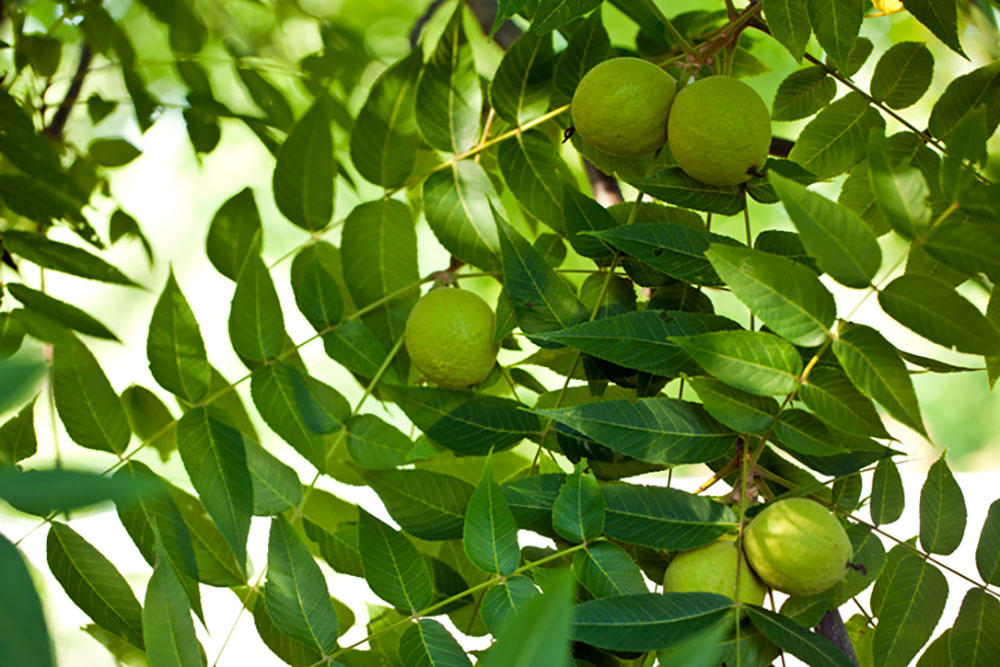By Stephanie Cavanaugh
Q: I HAVE A black walnut tree in my small backyard and can’t get anything to grow anywhere near it. Could it be cursed?
A: No. No, it’s not cursed. It’s a black walnut. A beautiful tree with magnificent wood and delicious nuts, BUT . . .
I’m glad black walnuts were not on my radar when we needed a tree in the backyard. We were in an angry mood, my Prince and I, when we went tree-shopping. This is not the best way to buy something that would be with us for decades. Possibly you know that.
See, we had these townhouses that went up behind our home in the Capitol Hill neighborhood of Washington DC. Four stories tall, blocking the previous view from the back porch of nothing but sky, an invasion of privacy—theirs and ours.
(I could say something here about the congressman’s wife who left her bedroom blinds up while dressing, but I won’t. We had a nice clear, pornographic view.)
Packing our umbrage into the truck, we headed for Homestead Gardens in Davidsonville, Maryland, which tends to many of our whims and fantasies.
We want a beautiful tree that will grow fast. Fast. We need to hide a terrible view, we (meaning I) said. And, we want our privacy back. Now.
So, we loaded a 12-foot Kwanzan cherry with a root ball the size of a Mini Cooper into the truck and tootled home. With the help of several neighbors, it was hauled into the garden. As promised, it grew fast and fabulously: 15 years later it’s 30 feet tall with a 15-foot canopy.
I suspect the giant neighborhood black walnuts had a similar genesis. Probably planted in the 1970s when the neighborhood had a lot of do-it-yourselfers with a Peace Corps/hippie aesthetic; one can imagine the gleam in the eyes of the planters. Not only would they hide unsightly neighbors, but there would also be free nuts, and the wood could be used for kidney-shaped coffee tables and kitchen counters and such. Tools were amassed.
The trees still stand, untouched by ax or saw.
Some years ago I wrote about Ken Jarboe, a neighbor who bought a townhouse near the Marine Barracks with a backyard filled with nothing but clay soil and weeds. But for a massive black walnut tree, it was a blank canvas.
Envisioning a Japanese garden, he added three cherry trees, a dogwood, and a meandering white stone path, “for a river effect,” he told me.
Everything died—except the black walnut, which has a lifespan of 250 years, give or take a decade.
The tree weeps a substance called juglone, which is toxic to most other plants in its vicinity. While its russet-colored sap is useful in hair and clothing dyes and wood stain, juglone dripped along that white stone path made it look like “a smoker’s teeth,” said Jarboe. “Instead of a nice river effect, it’s the Anacostia River on a bad day,” he added.
Gardening pro Melinda Myers suggests not putting susceptible plants within 50 feet of the tree. And make sure you account for the tree’s rapid growth (about a foot a year), and eventual height of 120 feet and 50 foot width.
That goes for your neighbor’s tree as well, which Maggie Hall and her husband, Gary Humfelt, found out when nothing grew beneath the branches of the enormous tree next door (which had taken root inside a garage and was allowed to grow right through the roof, “which made the garage pretty useless as a garage,” she told me).
“We loved it because it was handsome and provided widespread shade over our yard in the brutal heat of a DC summer,” she said. “But we hated it because it poisoned the soil.”
After several years of struggle, and many expensive floral failures, they discovered the black walnut was the culprit. “The only plant that survived the ravages of the poison were begonias. Not that they exactly flourished,” she said.
Among the plants that should limp along beneath the mighty canopy, are squills and snowdrops, for an early spring show, says Myers. For summer through fall, hosta, lungwort, Solomon’s seal, and Canadian ginger are known to be tolerant as well.
Forget removing the tree and cultivating roses. “The juglone remains in the soil until the roots, nuts, and leaves totally decompose,” she says.
One more thing. Forget relaxing in the tree’s generous shade as the nuts ripen. They’re hard, heavy and fall off the tree with “such an extraordinary force that the only way to safely spend time in the yard,” said Maggie Hall, “is by sporting a crash helmet.”


Glad to be of help:)
Wow! Now I don’t feel so guilty about cutting down the huge American Holly in my teeny back garden! Dropping very prickly leaves everywhere. I was told a fifty-year-old tree like that didn’t belong in a tiny city garden. So down and out it went, leaving me with a sunny, happy garden!!
Great article, and oh so true. But I think the black walnut’s killer effect on nearby plants also must spread through roots. One walnut tree in our yard has killed several red maples nowhere near the walnut’s canopy.